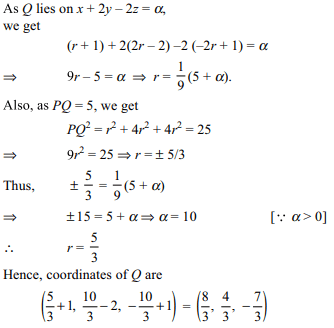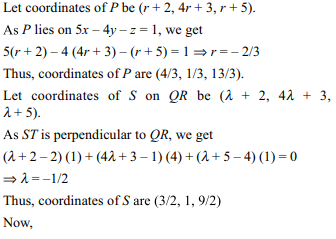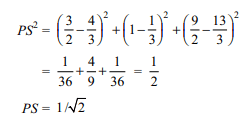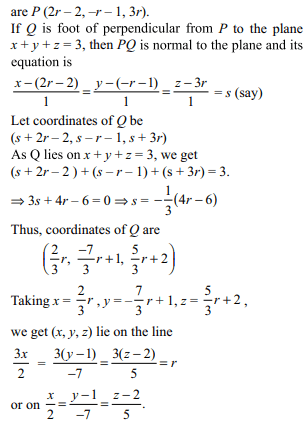1. Let P be the image of the point (3, 1, 7)
with respect to the plane x – y + z = 3. Then equation of the
plane through P and containing the straight line
\[\frac{x}{1}=\frac{y}{2}=\frac{z}{1}\]
is
a) x + y – 3z = 0
b) 3x + z = 0
c) x – 4y + 7z = 0
d) 2x – y = 0
Explanation: An equation of normal to plane x – y + z = 3 and passing through A(3,1,7) is

2. Equation of plane containing the straight line \[\frac{x}{2}=\frac{y}{3}=\frac{z}{4}\] and perpendicular to the plane
containing the straight lines \[\frac{x}{3}=\frac{y}{4}=\frac{z}{2}\] and \[\frac{x}{4}=\frac{y}{2}=\frac{z}{3}\] is
a) x + 2y – 2z = 0
b) 3x + 2y – 2z = 0
c) x – 2y + z = 0
d) 5x + 2y – 4z = 0
Explanation: Let a, b, c be the direction ratios of the normal to the plane containing the lines

3. If the distance of the point P(1, –2, 1)
from the plane \[x + 2y – 2z = \alpha\] , where \[\alpha >0\] , is 5, then the
foot of perpendicular from P to the plane is
a) \[\left(\frac{8}{3},\frac{4}{3},-\frac{7}{3}\right)\]
b) \[\left(\frac{4}{3},-\frac{4}{3},\frac{1}{3}\right)\]
c) \[\left(\frac{1}{3},\frac{2}{3},\frac{10}{3}\right)\]
d) \[\left(\frac{2}{3},-\frac{1}{3},\frac{5}{2}\right)\]
Explanation: Let Q be the foot of perpendicular from point P(1, –2, 1) to the plane x + 2y –2z = \[\alpha\]



4. The point P is the intersection of the
straight line joining the pionts Q (2, 3, 5) and R (1, –1,
4) with the plane 5x – 4y – z = 1. If S is the foot of the
perpendicular drawn from the point T (2, 1, 4) to QR, then
the length of the line segment PS is
a) \[\frac{1}{\sqrt{2}}\]
b) \[\sqrt{2}\]
c) 2
d) \[2\sqrt{2}\]
Explanation:



5. The equation of a plane passing through
the line of intersection of the planes x + 2y + 3z = 2 and
x – y + z = 3 and at a distance \[\frac{2}{\sqrt{3}}\] from the point ( 3,1,-1) is
a) 5x – 11y + z = 17
b) \[\sqrt{2}x+y=3\sqrt{2}-1\]
c) x + y + z = \[\sqrt{3}\]
d) \[x-\sqrt{2}y=1-\sqrt{2}\]
Explanation: An equation of the plane through the line of

6. Perpendiculars are drawn from points on the line \[\frac{x+2}{2}=\frac{y+1}{-1}=\frac{z}{3}\] to the plane x + y + z = 3. The
feet of perpendiculars lie on the line
a) \[\frac{x}{5}=\frac{y-1}{8}=\frac{z-2}{-13}\]
b) \[\frac{x}{5}=\frac{y-1}{8}=\frac{z-2}{13}\]
c) \[\frac{x}{4}=\frac{y-1}{3}=\frac{z-2}{-7}\]
d) \[\frac{x}{2}=\frac{y-1}{-7}=\frac{z-2}{5}\]
Explanation:


7. A triangle ABC is placed so that the mid points of its
sides are on the x, y and z axes respectively.
Length of the intercepts made by the plane containing
the triangle on these axes are respectively \[\alpha,\beta,\gamma\] , then the
coordinates of the centroid of the triangle ABC are
a) \[\left(-\alpha/3,\beta/3,\gamma/3\right)\]
b) \[\left(\alpha/3,-\beta/3,\gamma/3\right)\]
c) \[\left(\alpha/3,\beta/3,-\gamma/3\right)\]
d) \[\left(\alpha/3,\beta/3,\gamma/3\right)\]
Explanation: Equation of the plane containing the triangle

8. The reflection of the point P(1,0,0) in the line \[\frac{x-1}{2}=\frac{y+1}{-3}=\frac{z+10}{8}\]
is
a) (3, – 4, – 2)
b) (5, – 8, – 4)
c) (1, – 1, – 10)
d) (2, – 3, 8)
Explanation: Coordinates of any point Q on the given line are

9. Let P(3, 2 ,6) be a point in space and Q
be a point on the line
\[r =\left(i – j + 2k\right) + \mu \left(– 3i + j + 5k\right)\]
Then the value of \[\mu\] for which the vector PQ is parallel to
the plane x – 4 y + 3 z = 1 is
a) 1/4
b) -1/4
c) 1/8
d) -1/8
Explanation: Let O be the origin, as Q lies on the given line,

10. A line with positive direction cosines passes through the point P(2, -1,2) and makes equal angles
with the coordinates axis. The line meet the plane 2 x + y + z=9 at point Q.
The length of the line segment PQ equals
a) 1
b) \[\sqrt{2}\]
c) \[\sqrt{3}\]
d) 2
Explanation: An equation of a line through the point

